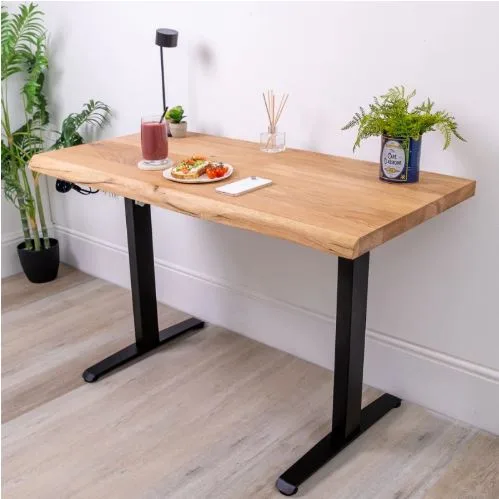Standing Desk Features That Truly Make a Difference
There’s a reason the office keeps circling back to the standing desk. It isn’t a novelty, and it isn’t a cure-all. It’s a prompt. A quiet nudge toward work that lets the body shift, the breath deepen, the mind stay alert. Used well, a standing table or an electric standing desk doesn’t shout; it removes friction and makes better posture and light movement feel ordinary. The difference comes from the details—the features that support real habits rather than wishful thinking.
Start with what the research actually says
The strongest argument for a standing desk is behavioural. People equipped with sit-stand workstations tend to cut sitting time during the workday, with reductions observed months after the novelty fades. The evidence shows meaningful drops in sedentary time across short, medium, and longer follow-ups when sit-stand interventions are implemented with simple prompts or education.
There’s a second point that matters just as much: movement, not passive standing, is the real lever. Ergonomists recommend alternating positions on a rhythm—sitting for a period, standing for a shorter spell, and sprinkling in small bouts of movement. A practical rule of thumb is the “20-8-2” pattern: roughly twenty minutes sitting in good posture, eight minutes standing, and two minutes moving. The exact minutes aren’t sacred; the habit of frequent change is.
Neutral posture principles still apply when you stand. Keep elbows near the body and bent around ninety to one-hundred-and-twenty degrees; set the monitor about an arm’s length away, with the top at or a little below eye level. This prevents the head from tipping up or the neck from craning down, the two postures that quietly drain your energy over a full day.
Finally, be wary of extremes. Long, unbroken standing creates its own issues; brief, regular standing and small movement breaks are the safer path. Even university guidelines for home and office setups suggest keeping standing stints modest and prioritising position changes.
With those anchors in place, the features that matter become clearer.
A height range that fits real bodies
Any standing desk rises and falls; a good one travels far enough to accommodate short and tall users, seated and standing, without compromises like perched shoulders or bent wrists. A useful benchmark comes from office ergonomics guidance: a height adjustability window in the region of ~22.5 to ~48.7 inches (with a typical 25–26 inch travel) covers roughly the fifth-percentile seated user through the ninety-fifth-percentile standing user. If your setup sits outside that band—say, you use a very thick desktop, or you’re particularly tall—look for frames with an extended range or a lower starting point.
Electric controls that eliminate friction
For many people, the difference between a “nice idea” and a daily habit is the control panel. Memory presets reduce every change to a tap. A quiet motor removes the social noise of adjustment in shared spaces. A smooth, predictable lift speed keeps the transition from feeling like an interruption. If you use multiple modes of work (typing, reading, sketching, video calls), dedicate a preset to each so the posture fits the task rather than the other way round. This is where an electric standing desk earns its keep—by making micro-adjustments effortless throughout the day.
Stability you can feel at the keyboard
Wobble at standing height is fatiguing in a way that sneaks up on you. Look for frames with solid lateral stability and minimal front-to-back flex. Multi-stage legs (often three-stage columns) increase usable travel without sacrificing rigidity; cross-members can help with wider desktops or heavy monitor arms. If you can, test with your real kit—or at least with a comparable load—and press lightly at the front corners while typing to feel how the desk behaves at your standing preset. Subtle instability is the kind of annoyance that slowly discourages use.
Anti-collision that prevents headaches (and repair bills)
People add drawers, cable spines, side cabinets, or simply leave things under the desk. An anti-collision system detects resistance and halts or reverses the lift before damage occurs. In busy spaces or home offices with children, it’s more than a convenience; it’s a practical safety net that protects the frame, the desktop, and whatever sits beneath it. If you plan to mount a treadmill, a cycle, or a CPU cradle, this feature pays for itself the first time it reacts.
A desktop that supports posture, tools, and touch
Depth matters. For most monitors and arms, a desktop that’s at least 700 mm deep allows comfortable viewing distance without pushing the keyboard to the edge. If you use a laptop on a stand plus an external keyboard, add a little more breathing room. Rounded edges or a soft radius at the front reduce forearm pressure during long sessions; a fine-grained, matte surface cuts glare and smudging. If you’re choosing solid wood, avoid racetrack bevels that shrink usable depth; if you prefer laminate, a high-pressure finish with a tidy edge band keeps the surface durable and easy to clean.
Cable management that stays tidy at every height
The first week with a new standing table can look spotless; the third month often reveals the truth. A proper management kit includes under-desk trays or channels, a way to anchor power bricks, and a vertical spine or loop that moves gracefully with the desk. The golden rule: power should rise with the frame. A small under-desk power strip, fed by a single floor lead, prevents cables from tugging or snagging when you stand. If you use a docking station, mount it toward the rear underside of the desktop to keep ports accessible and strain off the connectors.
Power that matches your devices
Modern setups draw more than they used to: ultrawide monitors, bus-powered audio interfaces, fast laptop chargers. A desk grommet with integrated AC and USB-C PD keeps the surface clean, but check the wattage—laptops often need 65 W or more to maintain charge during video calls. If you’re building from scratch, plan a single, surge-protected strip on the moving surface and a generous loop of mains cable to the floor outlet. The goal is silent confidence when the frame rises: no tugs, no snagging, no brown-outs.
Presets that reflect tasks, not heights
One preset for seated typing, one for focused standing, one for reading or sketching with the screen pushed back a touch, and—if you take calls—one for camera-friendly framing. Think in modes rather than millimetres. Pair those presets with small rituals: stand for the opening minutes of a meeting, sit for deep writing, stand again to review. Align the desk’s memory with your work’s natural rhythm and the habit keeps itself alive.
An interface that reminds, gently
Human attention drifts. Subtle reminders—on-panel LEDs, a soft buzz, or app prompts—do a simple job: they bring the “20-8-2” rhythm back into awareness without nagging. Used lightly at first, then tuned down once the habit sticks, reminders turn the standing desk from furniture into a small piece of behaviour design. The aim isn’t to chase numbers; it’s to stop hours from sliding by unnoticed.
Monitor arms, foot support, and the fine print of comfort
A well-placed monitor changes everything. An adjustable arm lets you nudge height and distance when you switch between sitting and standing. Keep the top of the screen near eye level and the centre a touch below; keep it directly in front of you to avoid neck twist. If your feet tire in the first weeks, a simple standing mat or a low footrest gives the ankles and calves something to do, encouraging subtle sway and weight shifts. These micro-movements, multiplied across a day, matter more than dramatic stints of rigid standing.
Noise, speed, and the texture of daily use
Motors that hum quietly and frames that move at a consistent pace make transitions feel uneventful—which is exactly the point. In an open office, low-noise lift acts like good manners. At home, it means you’ll adjust height without thinking about it. Speed only matters when it’s inconsistent; a steady travel rate builds trust, so you press the button and carry on with your sentence.
Weight capacity that reflects reality
Manufacturers often quote generous capacities. Think in systems. Add the desktop, the monitor or two, a laptop on a riser, speakers, an arm or two, perhaps a light. Then consider where the mass sits: a heavy monitor extended on an arm loads the front edge and magnifies wobble. A frame with real, felt stability will shrug off that asymmetry. If you’re close to the rated limit, choose a frame with a cross-member or a four-leg variant; both spread the work more evenly across the structure.
Build a setup that guides posture without fuss
Posture isn’t a pose to hold; it’s a comfortable range that you return to often. Keep wrists straight and level with the keyboard, elbows close, shoulders loose. Place the mouse beside the keyboard rather than forward of it. When standing, raise the worksurface so the keyboard sits roughly at elbow height; when sitting, do the same and let the chair do its work. Neutral positioning reduces strain that creeps in unnoticed across a week.
The habit that unlocks the value (without the marketing gloss)
A standing desk helps most when it becomes part of a wider routine that includes brief walks, light stretches, and simple cues. Keep a glass of water across the room; take calls on your feet; every hour, step away for sixty seconds. Interventions that add these small nudges often show the biggest gains in reduced sitting time and improved comfort, and they do so without demanding heroics.
Before you buy: a quick tactile test
If you’re in a showroom, try this sequence. Set the seated preset and type a paragraph; listen for hum, watch the screen for vibration. Stand and do the same; touch the front corners with light pressure while typing to feel for wobble. Raise the desk while a small box sits beneath it to check anti-collision behaviour. Slide your forearms along the front edge to test the radius. Look underneath: imagine where bricks and cables will live and whether they’ll travel cleanly. A standing desk that passes this simple trial will likely serve you well once the real work begins.
The short version, without shortcuts
Choose a standing desk with a thoughtful height range, quiet and reliable electric movement, real stability, and safety smarts. Give yourself presets tied to tasks, not numbers. Add clean cable management so nothing snags when you stand. Place the monitor with care. Build gentle reminders into your day. Then actually move—small, regular, easy movements that hold the health story together. The research points that way; ergonomic guidelines do too. The hardware only matters because it makes those choices effortless to live with.





